A Mezcal Guide to Oaxaca
Mezcal has been like an ever-present spirit since I first arrived in Oaxaca. It lurks on unsuspecting lunch tables, peeks out from behind every back bar, and consumes full pages of drink menus at top restaurants. Spot the tea light candle glass or the palm-sized jicara drinking gourds and there’s sure to be some mezcal nearby.
This article may contain affiliate links. This means if you click a link on my blog and make a purchase, I may earn a commission at no additional cost to you.
My first experience with mezcal was not one I’d want anyone to repeat. Here in Oaxaca, it’s not uncommon to have a mezcalero fill up a plastic water bottle of his or her clear and distilled liquid gold, something my hostel dorm roommate had apparently figured out quickly.
His orange-capped Bonafont water bottle sitting on the desk perfectly matched my Bonafont water-filled water bottle sitting by my bed. While in deep conversation and a bit distracted, I reached for the one on the desk by mistake. Before I knew it a large swig of throat-burning alcohol was streaming down my throat and pushing tears out of my eyes.
Far too shocked and embarrassed to admit what I had just done and experienced, I very casually walked back over to my orange-capped water bottle, recovering discreetly and chugging the correct clear liquid. Long story short, beware of the mismarked mezcal bottles that may be lingering around or you just might receive the same rude awakening I did to the world of Oaxacan mezcal.
Table of Contents
What is Mezcal?
Mezcal is a smokey liquor that packs a guttaral punch, often likened to scotch in its smokiness and flavor profile. It’s made from upwards of 30 different varietals of agave that grow all over Mexico. The type of mezcal you’re probably most familiar with goes by the name of tequila. However, tequila is strictly made with just one type of agave varietal - the Blue Weber. The mezcal consuming menu real estate and poking out from behind bars all over Oaxaca is made from every other variety, the most common of which is Espadin.
How is Mezcal Made?
Before I attempt to provide a snapshot of the extensive mezcal production process, I highly recommend you witness it with your own two eyes while in Oaxaca. Palenques (mezcal farms) dot the landscape all over the Oaxaca valley, making for an easy access and truly multi-dimensional mezcal drinking experience you can rewardingly reflect on with every future sip.
My personal introduction to the mezcal production process was during a very special sacred mezcal experience with Where Sidewalks End, a local Oaxaca tour company that prides itself on connecting travelers to off-the-beaten-path and authentic cultural experiences. On this tour, we had the chance to literally follow in the footsteps of a mezcalero named Don Conejo, shadowing him through every step of the ancestral mezcal-making process, from planting agave (also known as maguey) in his fields to bottling the final product. His palenque is located about an hour from Oaxaca City in Santa Catarina Minas. His land is teeming with both wild, semi-wild, and cultivated agave of all varieties.
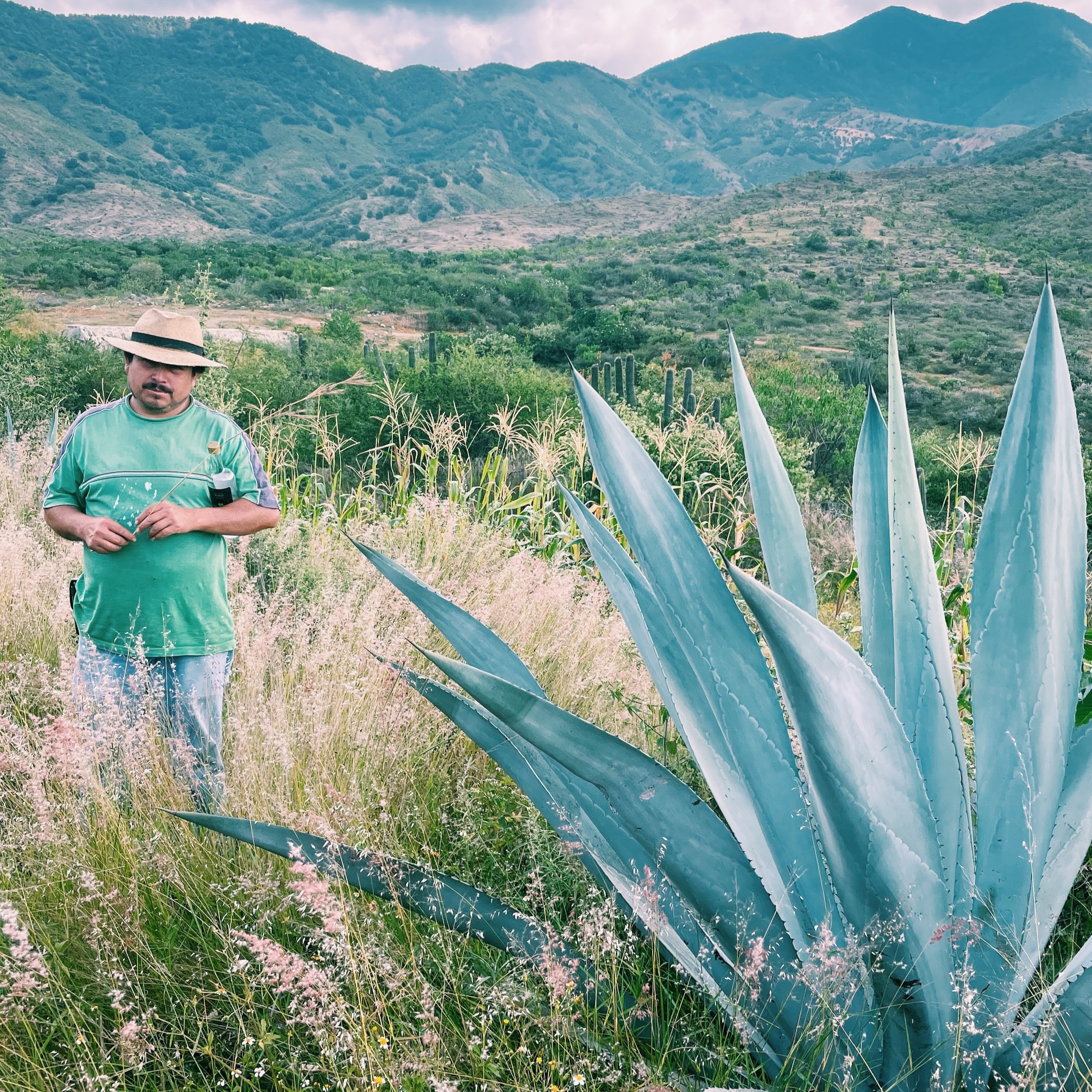
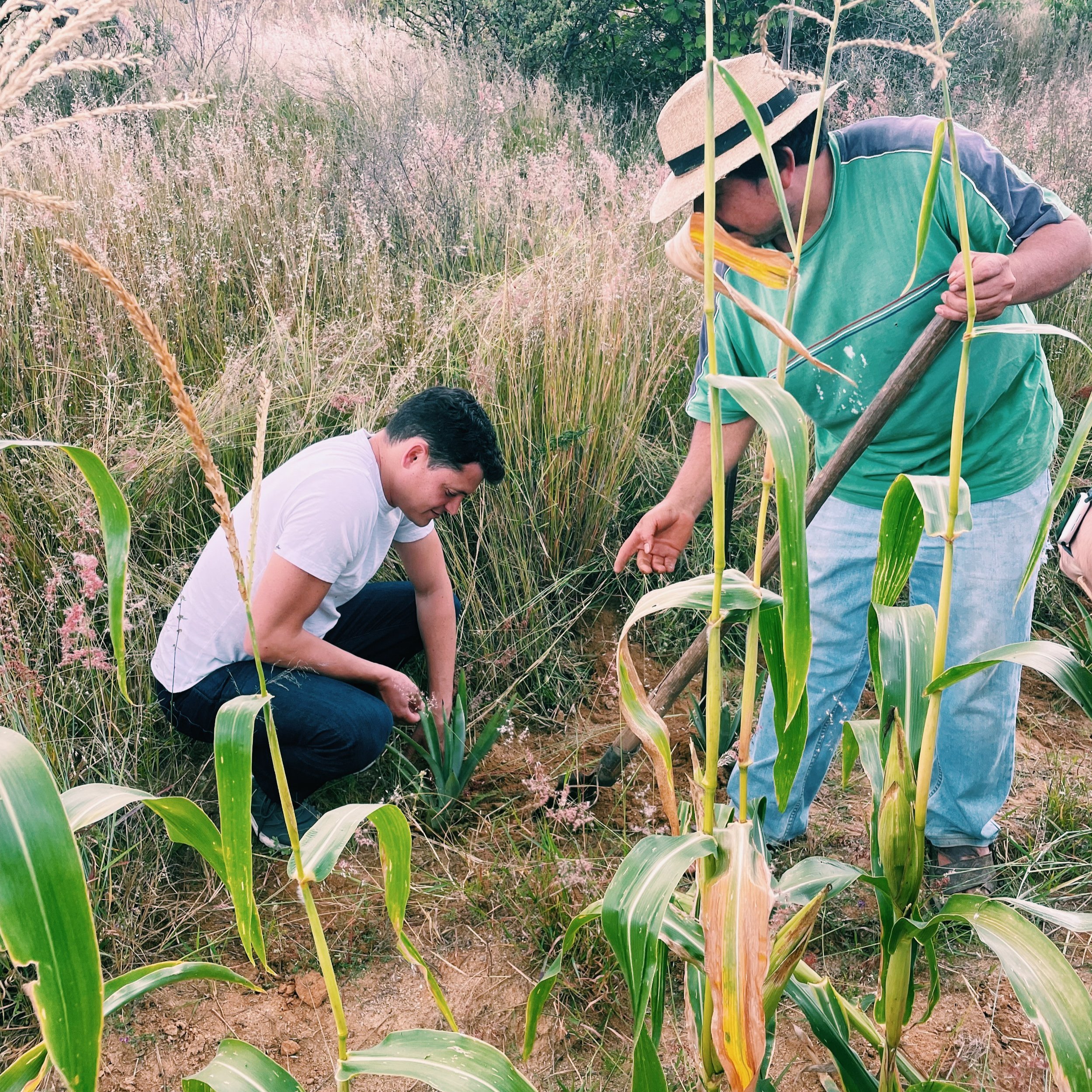
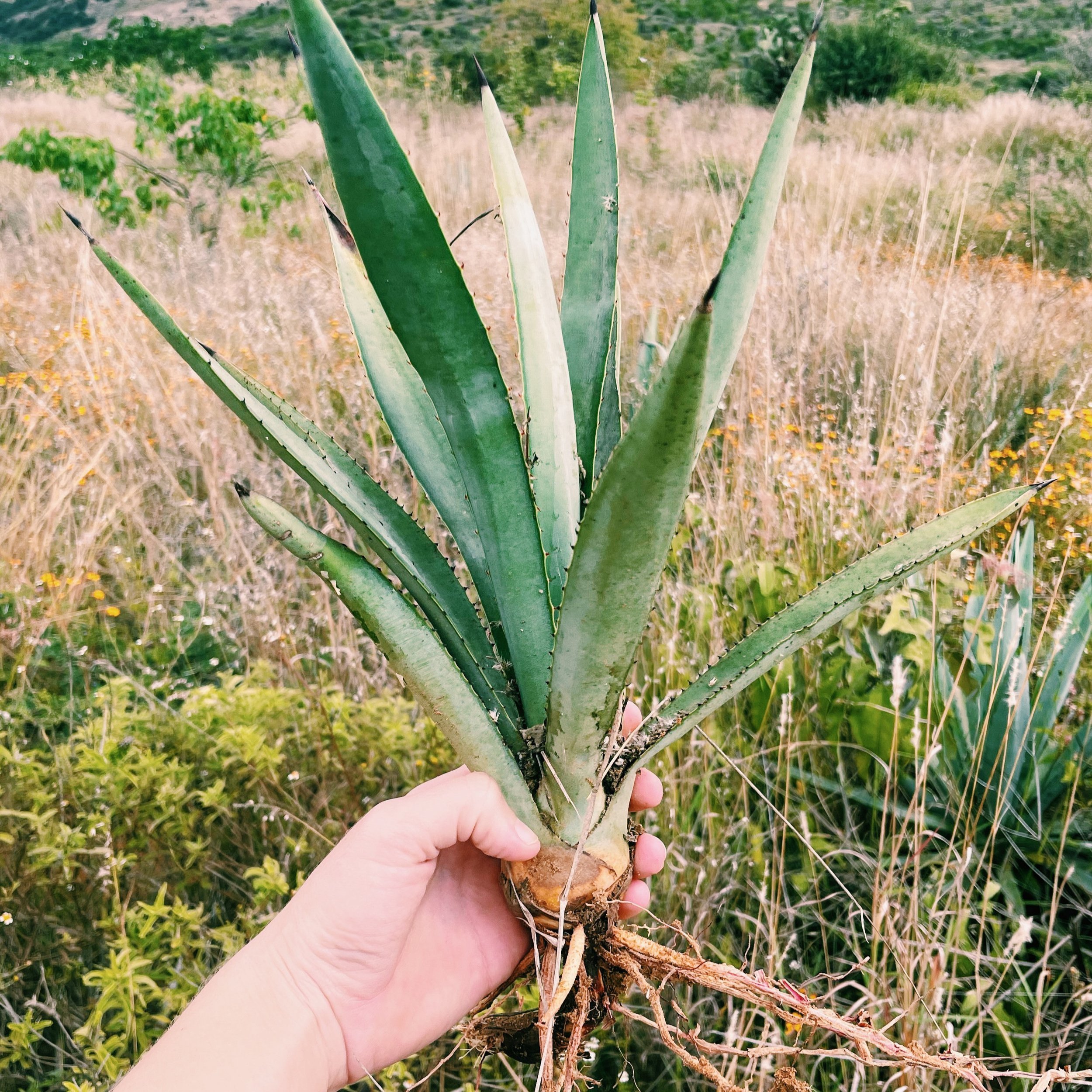
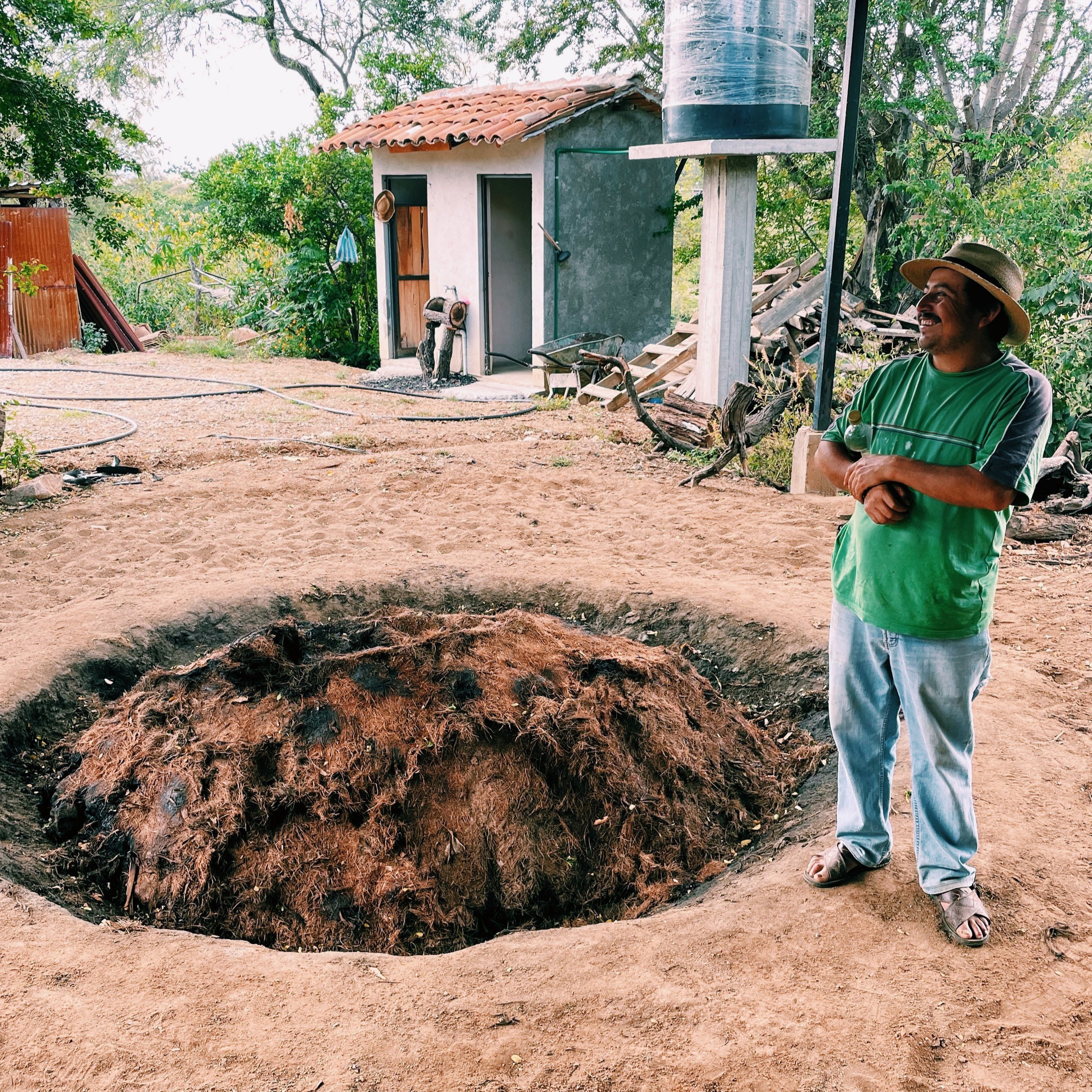
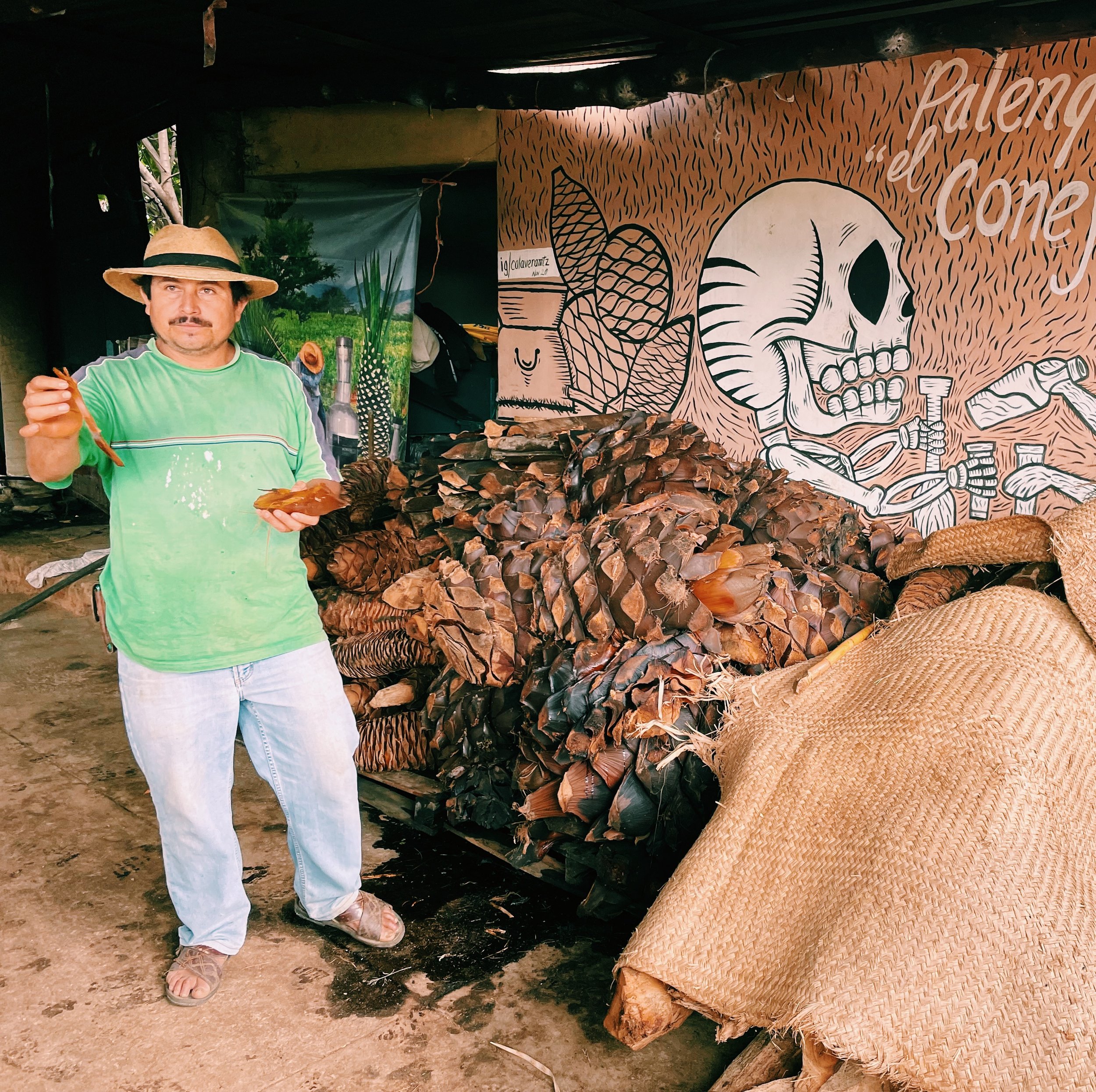
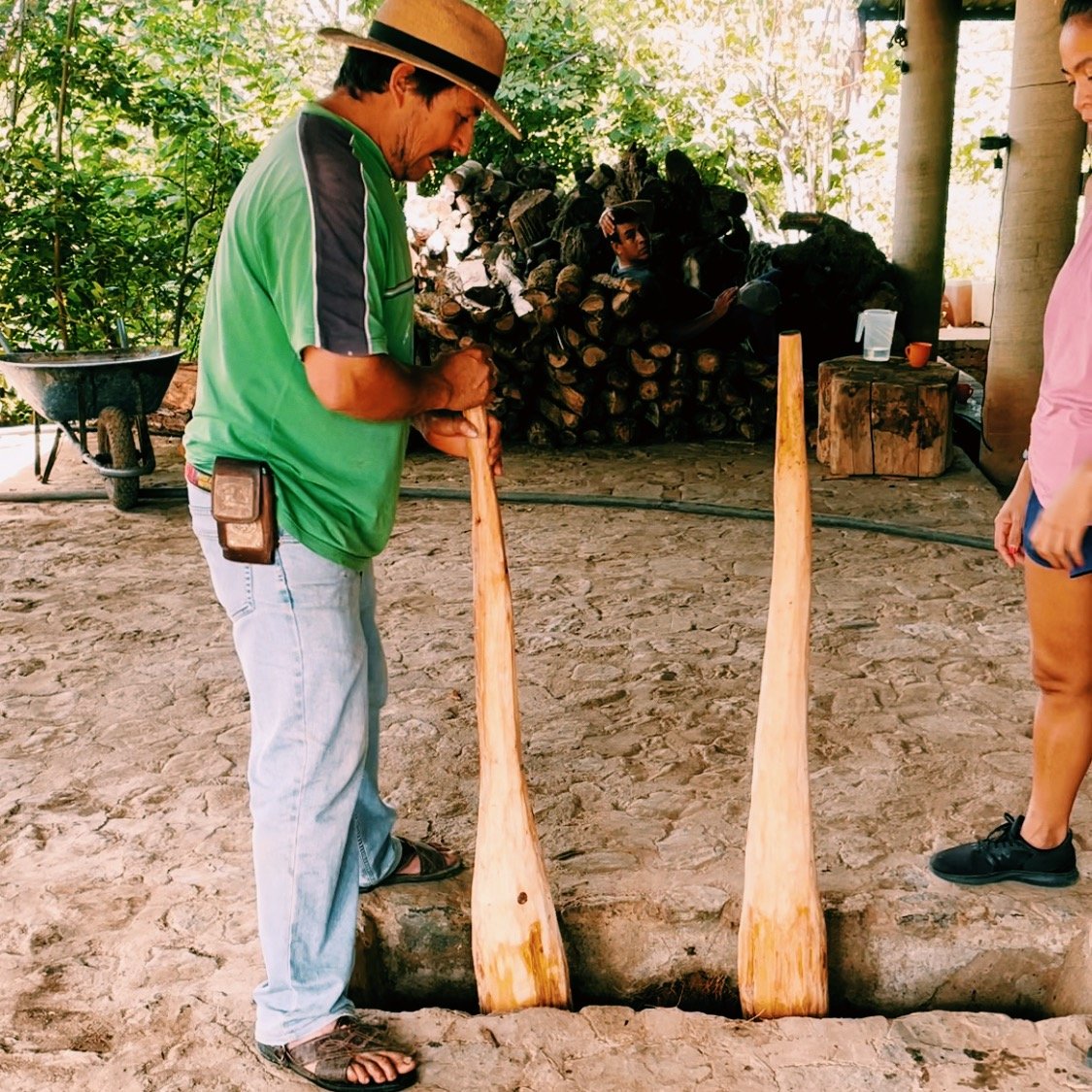
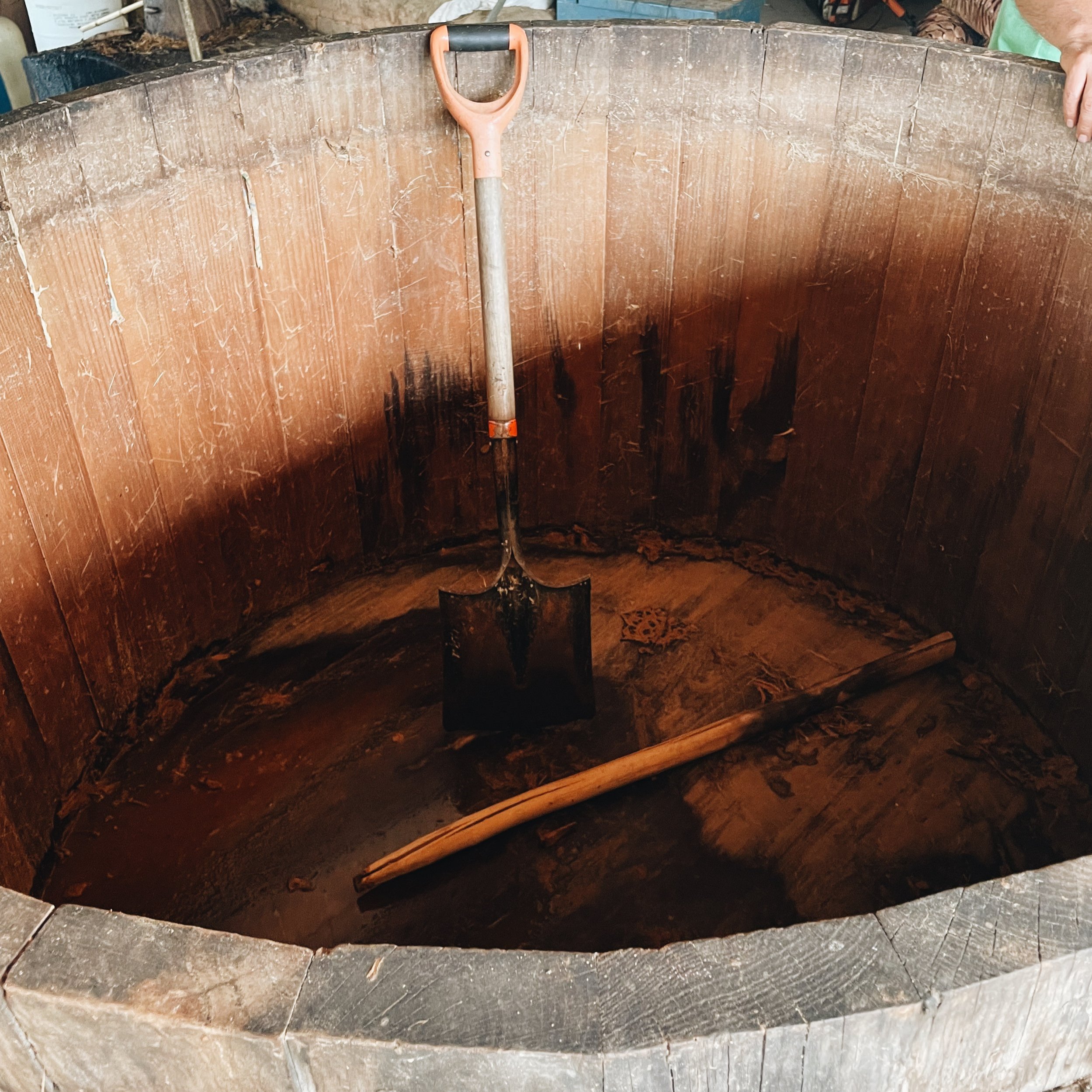
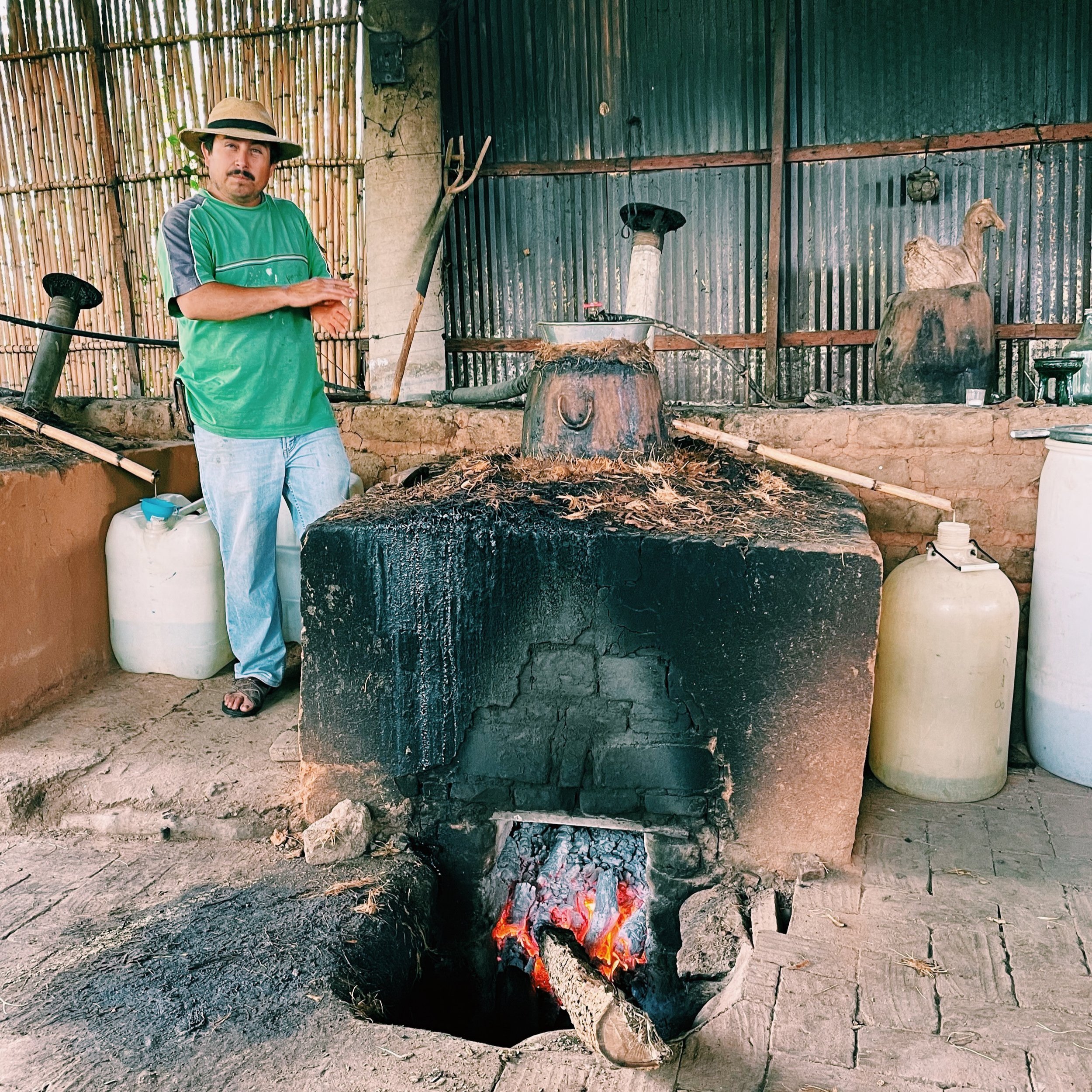
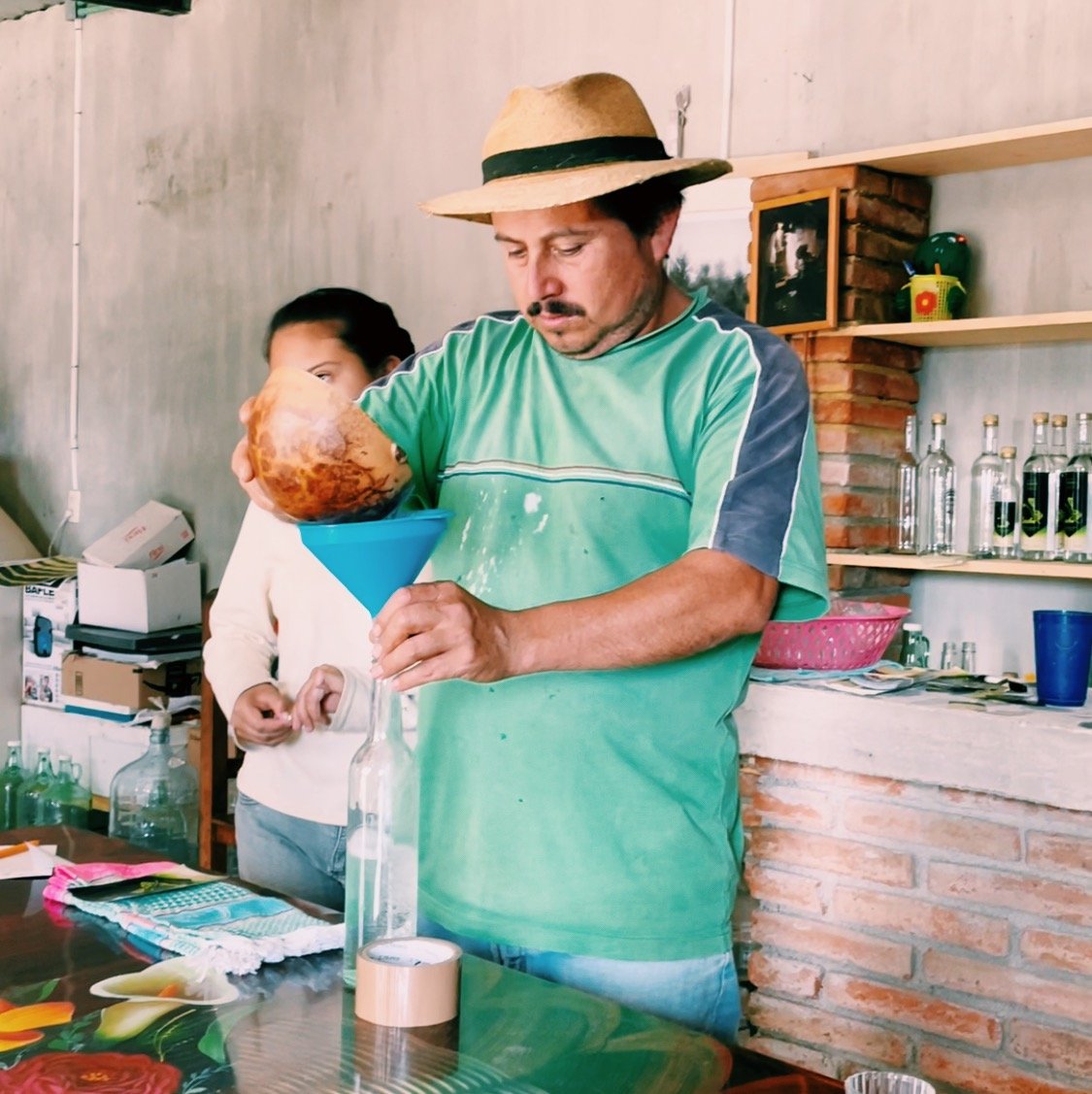
The mezcal production process begins with the planting of the baby agave plants, called hijos (or sons). On average, the maguey maturation process from hijo to ready-for-harvest can take about 7 years, while some agave can take as long as 25 years to mature. When harvest day finally arrives, the agave are uprooted and then roasted for days in a pit oven in the ground. This step right here is what gives mezcal its beloved smoky notes.
After roasting, the agave hearts, or piñas, are left to cool and, once cool, pressed by hand with a giant wooden mallet until the maguey is nothing more than a heap of agave fibers and wet syrupy pulp.
The now macerated maguey hearts are thrown into a wooden fermentation tank where they are left for one to four weeks to ferment. No yeast is added. The maguey ferment naturally with the support of ambient yeast and microbes present in the environment. A true mezcalero will know exactly when to transfer the fermented maguey to the distillation still. Before that time arrives, you’ll spot the mezcal master visiting the fermentation vat with increasing frequency, each time tasting, touching, sniffing, and watching until the mash has reached the optimal sugar and alcohol content for distillation.
The fermented mash is then transferred to the distillation still, fibers and all. El Conejo uses a clay-pot still to distill his mezcal, though copper is also common in the region. The mezcal is often distilled at least twice before its ready to be enjoyed. The first distillation yields a hard-to-drink liquid called shishe. After the shishe is distilled once more, sometimes twice more, the mezcal is ready for drinking.
How does one properly drink Mezcal?
What one does not do is throw it back like a shot…or gulp it down thinking it’s water. Mezcal is to be kissed, meaning sip it slowly and in small drip-like doses that merely coat your tongue. Take time between each “kiss” to appreciate the experience unfolding on your tastebuds. Notice the shift in profile as you move from the alcohol-heavy first kiss to the third and fourth, when new notes begin to come through. Before you even take your first sip, some locals will even recommend rubbing some of the mezcal in your palms to really catch the distinct aromas of the variety you’re sipping.
Though mezcal is commonly served with a side of orange slices and worm salt, any true mezcal afficionado would urge you to not mix the flavors. Focus on the mezcal, and if you need a palate cleanse between sips, grab your glass of water instead of reaching for the salted orange slice.
If you’re new to mezcal, it may be a good idea to try a mezcal cocktail first to warm up your senses to the mezcal drinking experience or ask the bartender or mezcalero for their least strong variety.
The Best Mezcal Experiences in Oaxaca
If you’re a regular reader of this blog, you’ll know that I’m not here to spoon feed you an itinerary or tell you exactly how to experience mezcal while in Oaxaca. Instead, I’d invite to peruse the options I lay out below and pay attention to which one(s) peaks your interest the most. Follow that intuitive hit and go on your version of the best mezcal experience in Oaxaca.
Visit a Palenque on a Guided Tour
This was by far my favorite way to experience mezcal. It brought entirely new dimension to the drink for me, especially now that I know it takes upwards of seven years for that baby agave to even be ready for the multi-week production process. As I mentioned before, I did my mezcal tour with Where Sidewalks End, but there are of course many other options out there, like Coyote Aventuras’ mezcal tour that combines a mezcal tasting with a hike around Hierve el Agua and The Mezcal Journey’s mezcal tour that takes you to both Mitla and Matatlan for a tour of the agave fields and a mezcal tasting. What I loved about my experience with Where Sidewalks End was how hands-on and informational it was. It truly felt like I was shadowing a mezcalero as he went about his daily business. Of course, I also loved sampling the mezcal at the end (and during), but for me it was witnessing the field-to-bottle process in its most authentic form that really blew me away.
Experience a Mezcal Tasting at a Mezcaleria in Oaxaca
There are a few spots in Oaxaca that are known for their exceptional mezcal tasting experiences. I’ve done the tasting at El Cortijo, but La Mezcaloteca and In Situ are also great options.
El Cortijo
Sip your way through three artisanal mezcals at this multi-generational establishment. The Méndez family of Santiago Matatlan has been producing mezcal since 1795. They opened their El Cortijo tasting room in 2012 and are considered to be one of the first brands of mezcal in Oaxaca. Their mezcal tasting is equal parts an introduction to mezcal production and variety as well as a guided experience into the aromas and flavors of each mezcal you try. I recommend going with a friend so you can double the number of mezcals you sample.
The Details:
Location: 5 de Mayo 305, Centro - View on Map
Price per Tasting:
3-mezcal tasting of their premium mezcals: 250 pesos
3-mezcal tasting of their invited brands of mezcal: 350 pesos
3-mezcal tasting of the ancestral-produced mezcals: 380 pesos
Duration: at your own pace
Availability:
Open Daily 3pm - 9pm
Walk-ins welcome up to 6 people. If more than 6, you can make a reservation via WhatsApp at +52 (951) 165 4801.
Mezcaloteca
Mezcaloteca’s appointment-only tasting is as much an educational experience as it is a trip for your tastebuds. This particular mezcaleria is known for its library-like collection of mezcal from family-owned brands and small-batch producers all over the Oaxacan countryside. All of the mezcals in their library are prepared in the ancestral mezcal tradition, meaning every sip is going to be unique and hard to repeat anywhere else.
The Details:
Location: Reforma 506, Centro (across from the Jardin Etnobotanico) - View on Map
Price Per Tasting:
3-mezcal tasting: 320 pesos
4-mezcal tasting: 360 pesos
5-mezcal tasting: 410 pesos
The cost is per person and includes a bottle of water.
Duration: 40 minutes to one hour
Availability:
Monday to Saturday 1pm - 6pm
Reserve online or give them a call at (951) 514 0082. This is an appointment-only mezcal tasting. No walk-ins accepted.
Mezcaleria In Situ
The owner of Mezcaleria In Situ, Ulises Torrentera, is known around town as a passionate mezcal curator, oftentimes tracking down mezcals made with the rarest of agaves. You won’t find a bigger or more unique mezcal collection in Oaxaca than the one hanging from the walls of his intimate tasting room in Centro. As the mezcal list can be slightly overwhelming, ask for a recommendation from Ulises himself or his wife Sandra who are often behind the bar. You’ll even receive an educational card that shares more about the agave used in the mezcal you’re drinking, its flavor profile, and the distillation process.
The Details:
Location: Vicente Guerrero 413, Centro - View on Map
Price Per Tasting:
3-mezcal tasting: 450 pesos
Duration: at your own pace
Availability:
Monday to Saturday 2pm - 11pm (their hours sometimes vary and may not match those currently listed)
Walk-ins welcome, or you can contact In Situ directly at (951) 514 1811.
Additional Options
Mezcal & Mole Tasting
Combine your mezcal tasting with a mole tasting alongside a professional sommelier who will take you through Oaxaca’s mezcal and mole scene.
Price: $76USD per person
Check Availability
Mixology Class with Mezcal
This is a great class to sign up for if mezcal is harder for you to sip straight. With a local award-winning bartender, you’ll learn how to mix your own mezcal cocktails using a variety of organically grown local products.
Price: $60USD per person
Check Availability
Organic Mezcal Tasting with Etnofood
Etnofood is a local social enterprise that combines gastronomy experiences for travelers with local youth empowerment. In this three-mezcal tasting at Espacio Mezcal, you’ll be hosted by youth from local mezcal cooperatives, some of whom are the children of the mezcaleros behind the mezcal you’ll be tasting or members themselves of the mezcal cooperatives. They’ll walk you through how to recognize the diversity of flavors, aromas, and textures of each small production mezcal you taste.
Price: $45USD per person
Check Availability
Go on a Do-It-Yourself Day Trip to the Nearby Mezcal Towns
Santiago Matatlan
Santiago Matatlan is considered the “cradle of mezcal” and it’s one of the most well-known mezcal communities in Oaxaca. Located about an hour from Oaxaca City, its streets are lined with dozens of small distilleries and shops where you can taste and purchase mezcal directly from the families that produce it. You can also pre-arrange or pop in for a tour and tasting at Gracias a Dios, Mezcal Macurichos, El Rey Zapoteco, or Desde La Eternidad to name a few.
How to Get to Santiago Matatlan: Take a colectivo from Central de Abastos at the corner of Periferico and Diagonal Mercaderes (view on map). Look for the wine red and white-colored cars with the name Santiago Matatlan written on the driver’s door. If you don’t find any of those, you can also take any of the colectivos that say San Dionisio Ocotepec or San Pablo Güila as well. Just tell the driver you'd like to get off in Santiago Matatlan. It shouldn’t cost more than 80 pesos per person.
Santa Catarina Minas
Santa Catarina Minas is another mezcal destination near Oaxaca City, just 45 minutes south of town. Like Santiago Matatlan, you’ll also find several distilleries and shops on the village’s main drag. Alternatively, you could pre-arrange a visit and tasting at any of the local family distilleries like Lalocura, Rambha Mezcal, and Real Minero.
How to Get to Santa Cantarina Minas: From Centro, you can take a van to Ocotlan from the Automursa station on Bustamante (view on map). It shouldn’t cost more than 50 pesos per person. In Ocotlan, you’ll look for the colectivos headed for Santa Catarina Minas located near the Zocalo (central plaza). If you don’t see them, ask any colectivo driver and they’ll point you to the correct car.
Sola de Vega
Sola de Vega is a bit of a hike at three hours’ drive from Oaxaca City. If you’re driving yourself to Puerto Escondido, it may be a solid stop en route as this traditional mezcal-producing town is located about half way to the coast from Oaxaca City. The palenque to visit is that of FaneKantsini, a family collective of multi-generational mezcal producers and one of the few with open doors to tourists passing through.
How to Get to Sola de Vega: I am not aware of any colectivos or vans that can get you to Sola de Vega. Renting a car is likely your best bet or you can sign up for a full-day tour with Tlayudona.
Where to Drink Mezcal in Oaxaca
You don’t have to go on a mezcal tour or book a tasting to enjoy mezcal in Oaxaca. There are plenty of mezcalerias, bars, and restaurants that are fully stocked and downright creative with this smoky spirit.
Mezcaleria In Situ and El Cortijo are two such places if you’re looking for a mezcal-focused experience, but there’s also Cuish, La Casa del Mezcal, and Mezcalogia that will satisfy that craving too. If you’re looking for mezcal in a rooftop setting, there’s Puro Burro, Los Amantes, and La Mezcalerita or for more of a dinner with a side of mezcal vibe, put your name down for a reservation at Los Danzantes, Expendio Tradicion, or Baltazar.
Where to Buy Mezcal in Oaxaca
While you could just stock up on take-home bottles of mezcal during your visit to the palenques or at your mezcal tastings at In Situ, Mezcaloteca, and El Cortijo, there are also several shops in Oaxaca that sell mezcal by the bottle, some of which will even give you a little taste before you buy. Talk about a perfect excuse to sample even more mezcal while tackling that list of things to buy for friends and family back home.
Mis Mezcales
Mis Mezcales is often the go-to recommendation for those seeking a bottle of artisanal mezcal to bring home with them. Their selection is highly curated and features mezcals from small-batch producer all over Oaxaca and greater Mexico. The owner and his staff are passionate about mezcal and will point you to the perfect bottle for you or your loved ones tastebuds. There’s even a tasting room where you can try before you buy.
Reforma 528B, Centro - View on Map
Mezcalillera
The inviting tasting room and shop at Mezcalillera is another great option when shopping for mezcal. They stock an impressive variety of artisanal mezcal brands from all over Oaxaca. I recommend grabbing a seat at the bar and letting the bartender walk you through a few tastings until you arrive at the mezcal worth the added weight in your luggage.
Murguía 403A, Centro - View on Map
Union de Palenqueros
For a truly unique mezcal shopping experience, visit the Union de Palenqueros, a space created by a group of mezcaleros from Santiago Matatlán. At their shop, you can try and buy distillations from some of the smaller home-based mezcal producers in Oaxaca. And don’t let the rustic interior and reused plastic soda bottle packaging fool you. These mezcals are top notch and at even lower price points than you’ll find anywhere else.
Mariano Abasolo 510, Centro - View on Map
Found this helpful?
I spend a lot of time in coffee shops putting together content like this. If you’d like to support my work, consider buying me a coffee to show some love ❤️
Support the Blog While You Travel
Travel and give back to the blog by booking things like your hotels, tours, and trip insurance through the links below. When you use these links, they send a bit back my way at no additional cost to you. Your support is much appreciated!
Accommodations: Booking.com for hotels, HostelWorld for hostels, and Vrbo for vacation rentals
Tours & Experiences: Viator, GetYourGuide, and TripAdvisor for tours, skip-the-line tickets, and experiences or GuruWalk for free walking tours
Flights: WayAway for booking, Hopper for knowing when to book, and Going for flight deal alerts
Buses, Shuttles & Transfers: Bookaway or 12Go for shuttles or transfers and BusBud for bus tickets
Car Rentals: DiscoverCars.com
SIM Cards & eSIMS: Airalo or Saily for eSIMS or Drimsim’s universal SIM card
Trip Insurance: Squaremouth for affordable single trip insurance and World Nomads for coverage that includes adventure sports and activities
Travel Gadgets & Gear: Amazon, REI, Osprey, Gregory, & Patagonia
Learn Spanish: Rosetta Stone, Babbel, and Pimsleur
Visit my Travel Resources page for even more ways to support the blog with your travel purchases.








